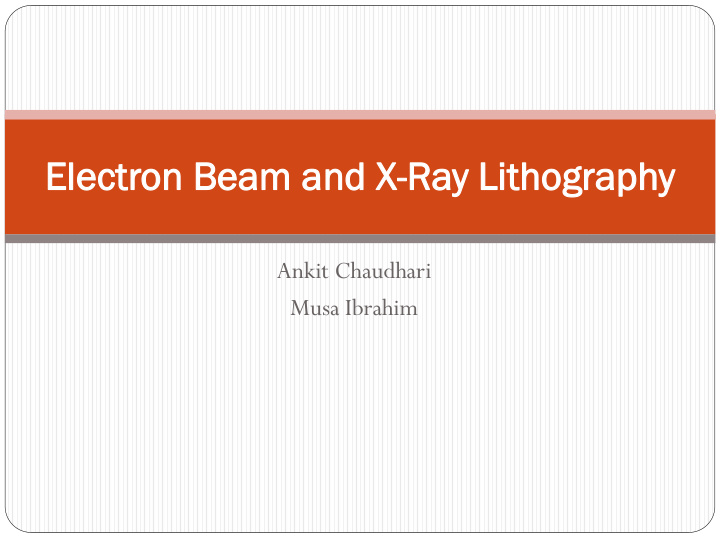



El Elec ectr tron on Bea eam and nd X X-Ray y Lit ithograph aphy Ankit Chaudhari Musa Ibrahim
Electron Beam Lithography: Application Electron beam Lithography (EBL) is used primarily for two purposes very high resolution lithography. fabrication of masks ( by etching process) It uses Serial Lithographic system
Electron Beam Sources Thermionic Emitters Electrons released due to thermal energy Photo Emitters due to incident radiations ( photons) Field Emitters due to applied current and quantum mechanical property of electrons.
Procedures of EBL Sample is coated with a thin layer of resist Polymethylmethacrylate (PMMA) PMMA breaks down into monomers upon exposure to electrons. The exposed regions can be rinsed away (developed) using a chemical Methyl-isobutyl-ketone (MIBK)
Advantages of EBL Print complex patterns directly on wafers Eliminates the diffraction problem High resolution up to 20 nm(photolithography ~50nm) Flexible technique
Disadvantages of EBL Slower than optical lithography. Expensive and complicated Forward scattering Backscattering Secondary electrons
Machine structure
EBL Components Deflection coils and lenses: to focus the electron Beam blanking: turning the beam on and off Stigmators: is a special type of lens used to compensate for imperfections in the construction and alignment of the EBL Colum. Vacuum: to isolate the electron beam from interferences
X-Ray Lithography: Application X-ray lithography is primarily used in nanolithography 15 nm optical resolution Utilizes short wavelength of 1 nm Simple: Requires no lenses Allows for small feature size
Procedures of X-Ray Lithography PMMA is applied to the surface of silicon wafer PMMA hardens when contacted with x-rays X-ray mask is applied on top of silicon wafer before exposure Absorber Membrane Synchrotron radiation (0.2 – 2 nm) Gap between substrate and mask
Advantages of X-Ray Lithography Short wavelength from X-rays 0.4-4 nm No diffraction effect Simple to use No lens Faster than EBL Uniform refraction pattern High resolution for small feature size
Disadvantages of X-ray Lithography Thin lens Distortion in absorber Cannot be focused through lens Masks are expensive to produce
X-Ray Lithography Machine Structure
Components Absorber – reduce scattering of X-rays Membrane – allows X-rays to travel through Vacuum- to isolate the X-ray from interferences
QUESTIONS?
Works Cited B. Braun, “Producing Integrated Circuits With X - ray Lithography” February 4, 2004, [Online]. Available: http://tc.engr.wisc.edu/uer/uer97/author7/index.html. [Accessed: 9/18/2011] B. Hans- Georg, “Electron Beam Lithography” September 22, 2008, UER Main,[Online]. Available: http://www.ipfdd.de/uploads/media/Lithohbmain_02.pdf .[Accessed: 9/18/2011] C. Friedrich, “X - Ray Lithography” March 1, 2000, [Online]. Available: http://www.me.mtu.edu/~microweb/chap1/ch1-4-2.htm.[Accessed: 9/19/2011] Y. Jiang, “Electron Beam and Conventional Lithography” UER Main,[Online]. Available: http://www.dssc.ece.cmu.edu/news/seminars/lunch05/headsmedia/041205 .pdf. [Accessed:9/19/2011]
Recommend
More recommend